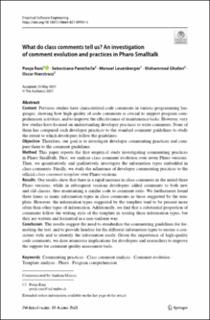Bitte benutzen Sie diese Kennung, um auf die Ressource zu verweisen:
https://doi.org/10.21256/zhaw-23353| Publikationstyp: | Beitrag in wissenschaftlicher Zeitschrift |
| Art der Begutachtung: | Peer review (Publikation) |
| Titel: | What do class comments tell us? : an investigation of comment evolution and practices in Pharo Smalltalk |
| Autor/-in: | Rani, Pooja Panichella, Sebastiano Leuenberger, Manuel Ghafari, Mohammad Nierstrasz, Oscar |
| et. al: | No |
| DOI: | 10.1007/s10664-021-09981-5 10.21256/zhaw-23353 |
| Erschienen in: | Empirical Software Engineering |
| Band(Heft): | 26 |
| Heft: | 6 |
| Seite(n): | 112 |
| Erscheinungsdatum: | 2021 |
| Verlag / Hrsg. Institution: | Springer |
| ISSN: | 1382-3256 1573-7616 |
| Sprache: | Englisch |
| Schlagwörter: | Commenting practice; Class comment analysis; Comment evolution; Template analysis; Pharo; Program comprehension |
| Fachgebiet (DDC): | 005: Computerprogrammierung, Programme und Daten |
| Zusammenfassung: | Context: Previous studies have characterized code comments in various programming languages, showing how high quality of code comments is crucial to support program comprehension activities, and to improve the effectiveness of maintenance tasks. However, very few studies have focused on understanding developer practices to write comments. None of them has compared such developer practices to the standard comment guidelines to study the extent to which developers follow the guidelines. Objective: Therefore, our goal is to investigate developer commenting practices and compare them to the comment guidelines. Method: This paper reports the first empirical study investigating commenting practices in Pharo Smalltalk. First, we analyze class comment evolution over seven Pharo versions. Then, we quantitatively and qualitatively investigate the information types embedded in class comments. Finally, we study the adherence of developer commenting practices to the official class comment template over Pharo versions. Results: Our results show that there is a rapid increase in class comments in the initial three Pharo versions, while in subsequent versions developers added comments to both new and old classes, thus maintaining a similar code to comment ratio. We furthermore found three times as many information types in class comments as those suggested by the template. However, the information types suggested by the template tend to be present more often than other types of information. Additionally, we find that a substantial proportion of comments follow the writing style of the template in writing these information types, but they are written and formatted in a non-uniform way. Conclusion: The results suggest the need to standardize the commenting guidelines for formatting the text, and to provide headers for the different information types to ensure a consistent style and to identify the information easily. Given the importance of high quality code comments, we draw numerous implications for developers and researchers to improve the support for comment quality assessment tools. |
| URI: | https://digitalcollection.zhaw.ch/handle/11475/23353 |
| Volltext Version: | Publizierte Version |
| Lizenz (gemäss Verlagsvertrag): | CC BY 4.0: Namensnennung 4.0 International |
| Departement: | School of Engineering |
| Organisationseinheit: | Institut für Informatik (InIT) |
| Enthalten in den Sammlungen: | Publikationen School of Engineering |
Dateien zu dieser Ressource:
| Datei | Beschreibung | Größe | Format | |
|---|---|---|---|---|
| 2021_Rani-etal_What-do-class-comments-tell-us.pdf | 4.64 MB | Adobe PDF |  Öffnen/Anzeigen |
Zur Langanzeige
Rani, P., Panichella, S., Leuenberger, M., Ghafari, M., & Nierstrasz, O. (2021). What do class comments tell us? : an investigation of comment evolution and practices in Pharo Smalltalk. Empirical Software Engineering, 26(6), 112. https://doi.org/10.1007/s10664-021-09981-5
Rani, P. et al. (2021) ‘What do class comments tell us? : an investigation of comment evolution and practices in Pharo Smalltalk’, Empirical Software Engineering, 26(6), p. 112. Available at: https://doi.org/10.1007/s10664-021-09981-5.
P. Rani, S. Panichella, M. Leuenberger, M. Ghafari, and O. Nierstrasz, “What do class comments tell us? : an investigation of comment evolution and practices in Pharo Smalltalk,” Empirical Software Engineering, vol. 26, no. 6, p. 112, 2021, doi: 10.1007/s10664-021-09981-5.
RANI, Pooja, Sebastiano PANICHELLA, Manuel LEUENBERGER, Mohammad GHAFARI und Oscar NIERSTRASZ, 2021. What do class comments tell us? : an investigation of comment evolution and practices in Pharo Smalltalk. Empirical Software Engineering. 2021. Bd. 26, Nr. 6, S. 112. DOI 10.1007/s10664-021-09981-5
Rani, Pooja, Sebastiano Panichella, Manuel Leuenberger, Mohammad Ghafari, and Oscar Nierstrasz. 2021. “What Do Class Comments Tell Us? : An Investigation of Comment Evolution and Practices in Pharo Smalltalk.” Empirical Software Engineering 26 (6): 112. https://doi.org/10.1007/s10664-021-09981-5.
Rani, Pooja, et al. “What Do Class Comments Tell Us? : An Investigation of Comment Evolution and Practices in Pharo Smalltalk.” Empirical Software Engineering, vol. 26, no. 6, 2021, p. 112, https://doi.org/10.1007/s10664-021-09981-5.
Alle Ressourcen in diesem Repository sind urheberrechtlich geschützt, soweit nicht anderweitig angezeigt.